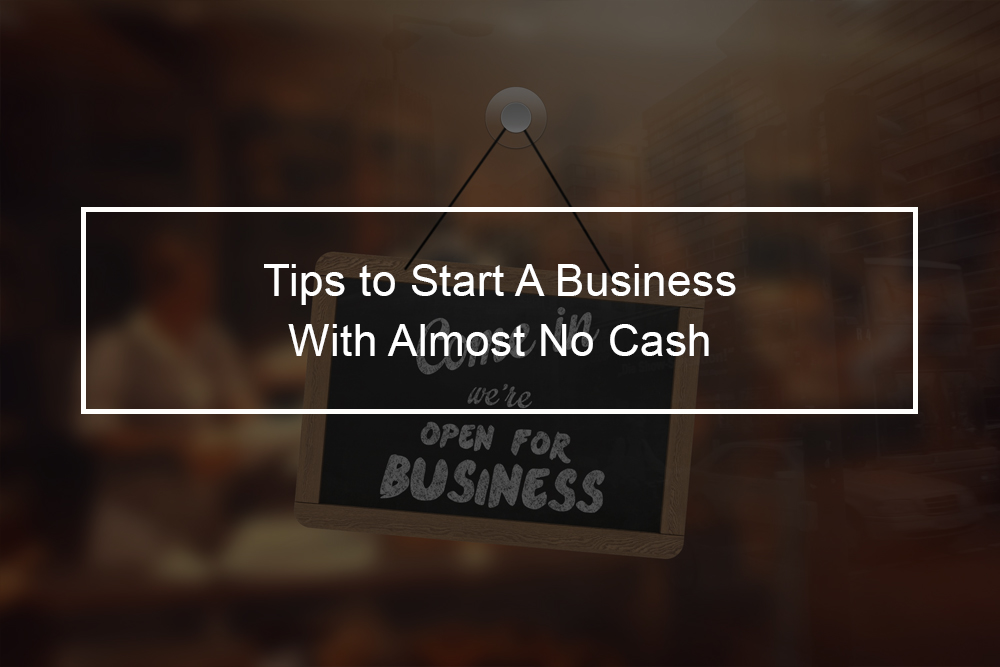
How to start a business with little to no money?
If you are like most Americans, you dream of starting your own business. But of course, many obstacles might keep you from actually doing that. You may not have enough motivation, for instance, or time actually to see the work through; or you may not even have a solid idea to start with yet. However, where most people get stopped cold is the realization that it takes money to embark on a business- money they do not have. Yet, consider: there are grants, loans, and other fundraising options, such as crowdfunding, accessible to get you what you need. Therefore money is not a good excuse not to begin a business. And, beyond that, there are certain kinds of businesses you can start with no cash.
When you are starting a business, you start small. Even better: you can start out small as you like. If you plan to open up a boutique shop, you can always begin by selling them to friends and family. You can establish a reputation and get initial feedback. Afterward, you can sell them on a third-party website online. Then, you can move on to hosting your own site and store. Do you get the idea? Typically, the businesses that emerge when entrepreneurs have limited capital and adopt the alternative mindest for new venture creation usually have specific characteristics. They frequently fall into one or more of the following broad categories: Performance, Events, Service, Education, or Brokerage. If you are concerned about how you can start a business without funds, here are a few ideas on where you can begin.
Step 1: Ask yourself what you can do and get for free
It is simple to develop a list of obstacles standing in the way of you and venturing into your business. It is frequently harder to come up with a list of opportunities that are right in front of you. In case the thought of embarking in a business with no money scares you, just stop and think about what you can do without at the moment. What is essential to your business? Do you require the slick, custom-crafted website when you have only perfected three products for your new store? Instead, could you do with developing a Facebook page to promote your business locally? Or, would it be more plausible for you to post your products for sale on a site such as Etsy? Would it be more reasonable for you to design your own marketing materials on Canva? Could you swap and trade your products or skills or resources with someone else in place of payment? Saying there are many free resources on the web is an understatement. Come up with a list of what you need for your business and then research free alternatives on the internet. It may take time, and maybe even require you to pick up some additional digital skills, but you will save funds when you need them most.
Step 2: Take into account who you know
What you can do right now and get for free needs to be merged with who you know for it to have a real impact. Take into account the relationships you have with others. Then map out your network of connections and consider how your connections could enable you to use what you have more effectively. Relationships, specifically equity partnerships, drive the shape and trajectory of the new venture.
Step 3:Build up six months’ worth of savings for expenses
In actuality, tapping into your savings account is not the ideal situation. However, it is a very common practice among entrepreneurs. When planning your business, be frank with yourself about how much you are spending and how much revenue you will likely bring in. Moreover, be realistic about how long it will take before you make a profit. Often, it takes about at least six months before you begin seeing any cash flowing in. Make it an objective to save at least six months’ worth of living expenses so you can devote yourself to your new business.
Step 4: Ask your friends and family for additional funds
Note that you are not asking for charity. You are not asking your family and friends to support your business idea. No, instead, you got a dream of business, and your business plan is solid. You have dotted the I’s and crossed your t’s. That is why you are looking to those closest to you when making your pitch. Use your family and friends as a multi-layered resource. Practice your sales pitch with them. Ask for feedback. And, when you are ready to launch your business, ask in case, they can assist with a small loan to start the business. Just ensure you write everything down in writing and when you will pay them back.
Step 5: Apply for a small business loan when you need additional cash
In case you are looking for more capital and have been operating on a shoestring budget, consider applying for a small business loan. Online lenders and banks provide differing kinds of small business loans to clients looking for additional cash flow or investment funds. You can always get more favorable terms with a traditional bank. However, online lenders are typically more lenient in their requirements. Just be careful with those high-interest rates.
Step 6: Look for small grants and local funding opportunities
In actuality, grants for small business are not always the simplest to find or get. However, after you have got your business up and running (despite how small), you can start searching in earnest for free cash. But always remember that grants will have specific application requirements. So long as you meet those, you are in the running for a bag of money that is all yours for the taking. Begin your search in government databases and always make sure you ask your local small business administration chapters for assistance.
Step 7: Invest only what you can afford to lose
There is a big difference in your perspective in case you start with the perspective that “you are investing this amount and expect a 40% return” versus “ You can afford to lose this much, so you will put it into the business and see if you can make it work.” In case you have only put in what you can afford to lose, you maintain flexibility in the business and reduce stress in managing it. In case you are only willing to invest when you anticipate that you can get a specific return, there is a strong possibility that you might never take the leap and launch the business you always dreamed of owning.
Step 8: Experiment and adapt
With this perspective, adaptability and flexibility are competitive advantages. You triumph not by becoming too fixated on a single objective or outcome but by being responsive to changes in the environment. Existing businesses typically take longer to adapt than new organizations since they have more inducement for things to remain constant, and they have developed routines and practices that reinforce the status quo.
New organizations are not bound to the way things have always been done. Therefore entrepreneurs can benefit from shifts in client preferences or changes in technology or shifting legislation by realigning their businesses to make excessive use of such developments. The entrepreneur with the alternative perspective, ‘in contrast, has to stand ready to make do with what comes his or her way and learn to transform both negative and positive contingencies into useful components of new opportunities. Typically, lack of funds, should not hinder you from pursuing your entrepreneurial dreams. With confidence in your idea and a clear vision of how you are going to execute it, you can do it. After you have that covered, getting the funds to support your dream might not be as challenging as it seems.











